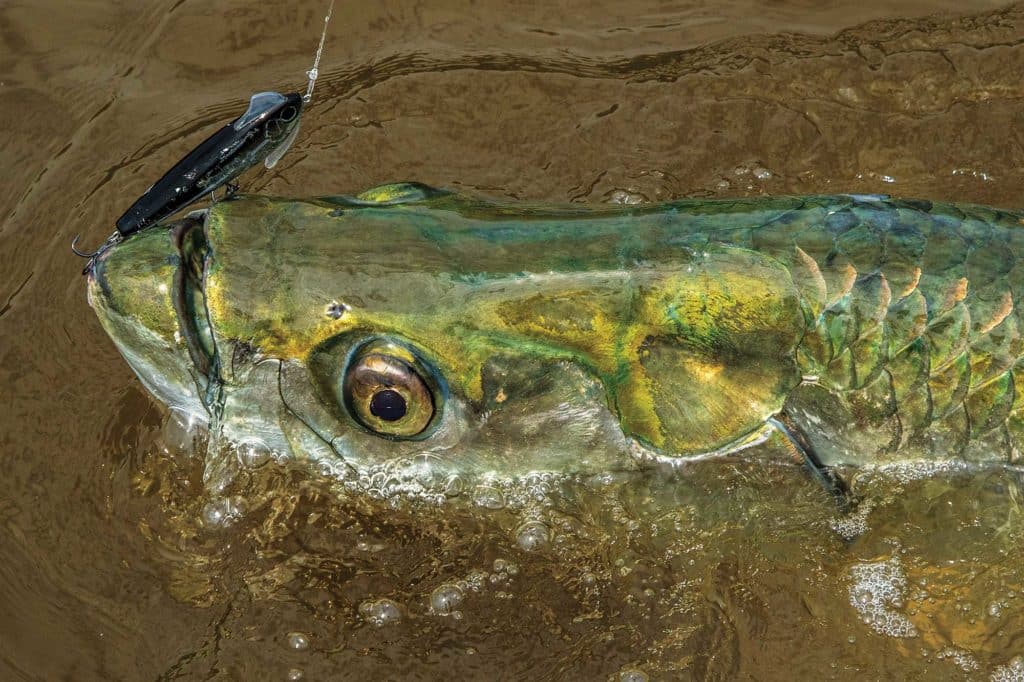
The untamed wilderness of labyrinthine rivers, creeks and bays that constitute Everglades National Park’s backcountry can be as intimidating as it is sublime. Despite their tricky navigation, these waters offer both amazing fishing and peace from South Florida’s concrete jungle just an hour away. It’s where you’ll find me in my skiff as often as I can get away, through winter and into spring, hunting for treasure — 100-pound ingots of living silver — the mighty tarpon. A friend introduced me to this world-class fishery in the late 1990s, and ever since, it has been an obsession of mine.
A high point in these years of obsession came during a recent January when Carl Ball (a charter captain out of Miami) and I found the mother lode of tarpon.
We left the Flamingo ramp at Buttonwood Creek, cleared Coot Bay and Tarpon Creek and, within 20 minutes, were hooked up to chrome‑plated ballistic missiles in Whitewater Bay.
A single tarpon had given up its location when its mirrored back reflected the sunlight piercing through the mangrove treetops. Pitching plugs about the same size as Carl’s half-smoked Cohiba on what could serve as bass-fishing tackle was the game. We jumped a dozen silver kings, mostly in the 80- to 100-pound range, landing four in two hours of fishing before we changed gears to target snook in the deeper recesses of the Glades.

Exploring the Maze
It’s never easy figuring out a fishery, especially one that takes place within a maze. The vastness of the Everglades is overwhelming (offering visitors a reminder just how insignificant we really are). The place can’t be tamed but learned only slowly through hard work and persistence.
The latest GPS technology offers anglers the chance to navigate these waters in ways never available to early pioneers. My Raymarine Axiom 9 chart plotter with Navionics Platinum+ satellite imagery opened wilderness doors when that chart chip became available in 2007. Having the benefit of satellite imagery in a GPS provides a bird’s-eye view for navigating and also offers an effective tool when trying to find lee shores on windy days. I wouldn’t venture there without it.
Even with such electronics, I file a float plan with family or friends before fishing the Glades. A current, registered, personal ACR ResQLink personal locator beacon or Garmin inReach Explorer satellite communicator is also a plus in case of emergency. There’s no TowBoatUSA or SeaTow to help you.
As an angler who fishes these waters, I’ve learned much by chatting with seasoned guides who obviously share the same passion for the park and its tarpon. Capt. Steve Tejera specializes in fishing the backcountry 200-plus days a year. Tarpon can be found all year in the many rivers, creeks, back bays, shallow mud flats, basins, mangrove shorelines and around oyster bars. Still, Tejera feels that knowing in which areas he’ll find tarpon during certain conditions and times of the year greatly improves his catch stats.

Seasonal Strategies
“During the winter months, from December through March, 100-pound-class tarpon can be plentiful in the backcountry,” Tejera says. When water temperatures rise between cold fronts, you can expect the tarpon to be active, according to Tejera. The tarpon funnel into the large back bays such as Whitewater, Tarpon and Broad River, moving in from the Gulf looking for stable, warm freshwater environments.
In cold, northerly winds, the fish move out of these bays or hunker down on the bottom and get lockjaw, but after a window of three or four days of warmer southeasterlies, especially after a cold front, the fishing can light up in those places, Tejera says.
When temperatures remain mild for long periods during February and March, coupled with winds from a generally easterly direction, the fish move from back bays to the outside capes — East Cape, Middle Cape and Northwest Cape, and also out in front of Flamingo.

Still longer periods of stable weather with water temperatures in the magic 72-to-74-degree range might create the perfect situation for laid-up fish, a spectacle that has to be witnessed firsthand to believe. Tarpon lying motionless in the upper part of the water column can be discerned by a telltale golden smudge a few inches below the surface. If you can distinguish the fish’s head from its tail, throwing a plug or soft-plastic jerkbait can end up in a tug-of-war of epic proportions. When things are really good, you might see the tips of tarpons’ dorsal and tail fins above the water’s surface. Witnessing scenes like this that will get any angler’s heart racing.
Around March and April, the fish begin staging near river mouths and open bays to begin their migrations to spawn in the Keys, Tejera says. That’s also around the time cold fronts dwindle. From May through June and into July, the fish can be intercepted as they advance to the south in packs or strings over the cleaner-water banks — First National Bank, Sandy Key Basin and Oxfoot Bank.
From August through November, the bights — Snake, Garfield and Rankin — consistently hold fish in 5-to-20-pound range. “Out front is better in the summertime,” says Tejera of Florida Bay. “The back bays heat up quicker, and it’s typically too hot for tarpon.” He believes they relocate out into Snake Bight Channel and Tin Can Channel and in all the large basins between shallow mud flats. “In late November and December when baitfish are thick, fun-size 40- to 50-pounders move into the channels and will even venture up on the flats,” he says.

Fish ‘Em Like Salmon
“West wind makes fishing the park tough,” Tejera says. “The water becomes turbid, and tarpon roll less because there might be more oxygen in the water.” When cool northern winds associated with an approaching cold front shut things down, he changes gears and targets snook and redfish. If they’re not blowing too hard, consistent southeasterly breezes are always a blessing.
The search for giant tarpon in such a vast place can range from minutes to hours. Start searching early because they roll less when the sun rises overhead or wind picks up. Rollers and free-jumpers offer obvious tarpon signs, but so do diving seagulls and nervous baitfish schools. “If you find tarpon rolling in a river, you never want to idle your skiff against the current because they’ll feel your pressure wave,” says Capt. Bob LeMay (954-435-5666, lemaymiami@aol.com). He fishes the tarpon in rivers the same way he fishes for Alaska’s salmon, observing where they are and casting up-current from them, starting his retrieve only when the plug reaches that zone.
For gear that can cast plugs all day but still handle 100-pound fish, I prefer a 7-foot-2-inch medium-heavy Shimano Terez Waxwing. It has something of the look and feel of a bass-fishing rod but is actually designed for large pelagic species. You want a rod that will handle 30- to 50-pound braided line. (I used this same rod to haul in a 200-pound-class yellowfin tuna on a popper at Hannibal Bank, Panama.)
Hurling plugs as far as you can in wide-open bays requires a reel that has sufficient line capacity yet balances well with the lightweight rod. For example, a Shimano Stradic STC5000 is a good fit, with good line capacity for 30-pound braid, plenty of drag and a fast gear ratio.
“Keep the rod tip low when fighting tarpon,” Tejera advises. “The rod tip down in the water creates drag on the line and resistance on the hook to help keep it lodged. Since tarpon stay near the surface for most fights, I tell my clients to keep the rod tip down, and if the fish jumps, don’t bow; relax your wrist to maintain light resistance with no slack. Bowing to them takes too much pressure off the hook, and more times than not, the fish eventually jumps off that way,” he says.

Lure Picks ‘n’ Tricks
In scientific terms, tarpon have a superior lower jaw, best described as a massive underbite. Because their lower jaw extends far beyond their gape, tarpon excel at hunting prey at or above eye level. Additionally, the extremely bony mouth of these prehistoric fish makes them challenging to consistently hook and land.
In fact, a study done in 2004 by the Florida Fish and Wildlife Conservation Commission showed that only 37 percent of hooked tarpon actually made it to the boat. Having experienced similar results, I’ve learned a couple of tactics to help keep the odds in my favor.
Since the standard treble hooks found on most lures are not designed for big tarpon, I change out the hooks.
One strategy is to use size 2 Mustad KVD Elite Triple Grip trebles, size 1 VMC 4X Model 9626, or Owner Stinger 4X ST-66 trebles. I also sharpen them with a stone and mash their barbs slightly to improve penetration.
You can change out trebles to stronger versions (such as Mustad KVD Elite Triple Grips, VMC 9626 4X or Owner Stinger ST-66 4X, generally in a size 2). However, a better tactic — which helps keep tarpon hooked longer and is better for the fish — calls for replacing trebles with 2/0 VMC 7237CB in-line single X-strong large-ring hooks. In-line singles hold better, allowing more drag pressure with less chance of straightening, and are much safer when landing tarpon for fish and angler.

Slow-sinking and suspending plugs produce more bites for me than straight-up sinking lures. Plugs such as MirrOlure’s Catch 2000 and MirrOdine XXL are my go-to choices. The black-back fluorescent-orange-belly pattern (808 color) works well mornings and evenings when the light is low. With the sun high and bright, I switch to lighter MirrOlure patterns in silver (S color), mullet (21 color) or chartreuse (CFPR and CH colors). Tejera prefers darker colors like black and purple in stained water. He also likes the slow-sinking Egret Baits Vudu Mullet that stands up well to the abuse of multiple fish fights. These are made of TPE — thermoplastic elastomers, a much stronger plastic polymer used in many new lure designs.
Rapala’s new X-Rap Twitchin’ Mullet in bone-chartreuse, mullet and mangrove-minnow patterns has proved highly effective for big tarpon in the backcountry. The lure has a slow sink rate and wide, twitching, walk-the-dog swimming action, and comes standard with high-quality 2/0 in-line VMC hooks. Other great choices include the suspending Shimano Waxwing, Bomber Long-A and Badonk-A-Donk, and the suspending LiveTarget Mullet Twitchbait.
Read Next: Fishing for Tarpon
“If I had a personal choice for tarpon, I’d throw big soft plastics on single hooks over plugs,” says well-known Flamingo guide Capt. Benny Blanco. “We’re all more conservation-minded now, and treble hooks are simply not good for any catch-and-release fishery.” In water no more than 4 feet deep, Blanco has his clients pitch unweighted Saltwater Assassin S.W. Shad and Hogy 7-inch plastic jerkbaits with heavy-duty 4/0 or 5/0 Mustad KVD Grip-Pin soft-plastic hooks. If the fish run deeper, Blanco puts the baits on a jig head or on ¼- to ½-ounce weighted Mustad Grip-Pin worm hooks.
“While the long-term effects on the park’s ecology remain to be seen post-Hurricane Irma (2017), I do see positive signs,” Blanco says. He believes the storm helped clear out silt brought in from earlier hurricanes, and in many areas pushed out the decaying sea grass from the die-off a year prior. December 2017 offered some of the best tarpon bites Blanco can remember, with multiple days hooking 20 or more tarpon. “It was truly magical,” Blanco says.
About the Author
Adrian Gray began fishing in South Africa, where he was born. He’s now the creative designer for the International Game Fish Association, responsible for publication design, photography, digital media, Web, art/illustration and editorial content, and contributes photos to a number of popular magazines, including Sport Fishing.









